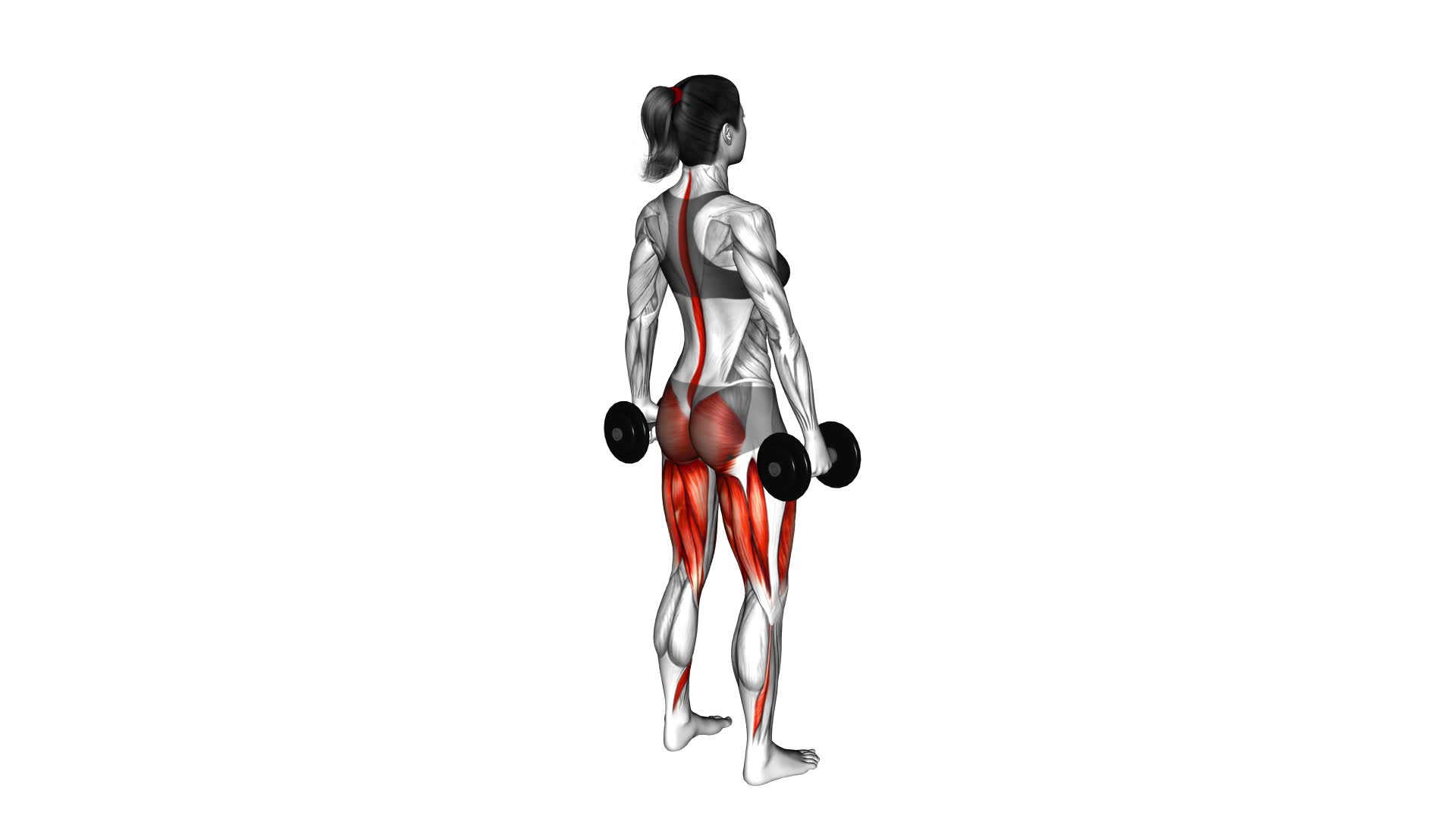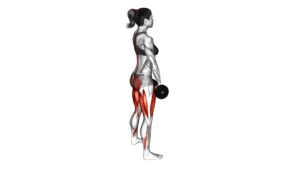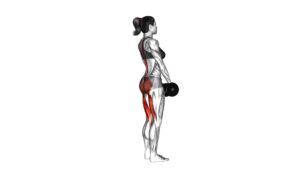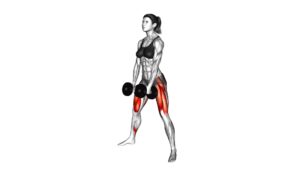Dumbbell Deadlift (female) – Video Exercise Guide & Tips

Get ready to transform your workout routine with the dumbbell deadlift!
Watch This Exercise Video
This exercise is perfect for women looking to build strength and tone their muscles. In this video exercise guide, we'll show you the proper form and technique to maximize your results.
Plus, we'll share common mistakes to avoid and variations to challenge yourself.
Whether you're a beginner or advanced, incorporating the dumbbell deadlift into your fitness routine will take your workouts to the next level.
Let's get started!
Key Takeaways
- Dumbbell deadlift targets multiple muscle groups simultaneously, including the glutes, hamstrings, quadriceps, and lower back.
- It improves core stability and balance.
- Dumbbell deadlift increases overall strength and power.
- Incorporating dumbbell deadlift into a fitness routine can enhance performance in daily activities and help achieve fitness goals.
Benefits of Dumbbell Deadlift for Women
You can experience numerous benefits from incorporating dumbbell deadlifts into your workout routine as a woman. Female strength training is essential for overall fitness and health, and dumbbell exercises for women can be highly effective in achieving your fitness goals.
One of the main benefits of dumbbell deadlifts is that they target multiple muscle groups simultaneously. This compound exercise engages your glutes, hamstrings, quadriceps, and lower back, helping to strengthen and tone these areas.
Additionally, dumbbell deadlifts are a great way to improve your core stability and balance. The exercise requires you to maintain a neutral spine and engage your core muscles throughout the movement, resulting in improved posture and reduced risk of injury.
Moreover, incorporating dumbbell deadlifts into your routine can increase your overall strength and power, helping you perform daily activities with ease. Whether you're lifting groceries or playing sports, the strength gained from dumbbell deadlifts can enhance your performance.
Proper Form and Technique for Dumbbell Deadlift
To perform the dumbbell deadlift with proper form and technique, it's important to focus on engaging your core muscles and maintaining a neutral spine throughout the exercise. This will help you maximize the benefits of the deadlift for strength training and reduce the risk of injury.
First, stand with your feet hip-width apart, holding the dumbbells in front of your thighs with an overhand grip. Keep your shoulders back and down, and maintain a slight bend in your knees.
Next, hinge at your hips and lower the dumbbells towards the ground, keeping your back straight and your chest lifted. As you lower, imagine pushing your hips back and maintaining a straight line from your head to your tailbone.
Once the dumbbells reach the ground, engage your glutes and hamstrings to drive your hips forward, lifting the dumbbells back up to the starting position. Keep your core tight and your shoulders pulled back throughout the movement.
If you're unable to perform the dumbbell deadlift, there are alternative exercises that can provide similar benefits. These include the kettlebell deadlift, barbell deadlift, or Romanian deadlift. These exercises target the same muscle groups and can help improve your overall strength and power.
Remember to always start with lighter weights and focus on proper form before progressing to heavier loads.
Common Mistakes to Avoid During Dumbbell Deadlift
One common mistake to avoid during the dumbbell deadlift is improper foot positioning. Proper foot positioning is crucial for maintaining stability and preventing injury during this exercise. Many people make the mistake of having their feet too close together, which can lead to a loss of balance and potential strain on the lower back. To avoid this, make sure to keep your feet shoulder-width apart, with your toes pointing slightly outward. This wider stance will provide a solid base of support and allow for proper alignment of the knees, hips, and spine.
Another common mistake is rounding the back during the movement. This can put excessive stress on the spine and increase the risk of injury. To avoid this, focus on maintaining a neutral spine throughout the exercise. Engage your core muscles and imagine a straight line from your head to your tailbone. Keep your chest lifted and your shoulders back, allowing the weight to be lifted using the muscles of the legs and hips rather than the lower back.
For beginners or those with limited mobility, modifications can be made to ensure proper form and reduce the risk of injury. Using lighter weights or starting with bodyweight-only deadlifts can help build strength and confidence before progressing to heavier weights. Additionally, performing the exercise with a kettlebell or using a trap bar can provide a more comfortable grip and less strain on the wrists.
By avoiding these common mistakes and making appropriate modifications, you can perform the dumbbell deadlift with proper form, reducing the risk of injury and maximizing the benefits of the exercise.
Now, let's move on to the next section and explore variations and progressions of the dumbbell deadlift.
Variations and Progressions of Dumbbell Deadlift
To explore variations and progressions of the dumbbell deadlift, start by incorporating different grip positions to target specific muscle groups. Here are some modifications and challenges you can try to enhance your dumbbell deadlift workout:
- Single-arm dumbbell deadlift: Perform the deadlift using only one arm at a time. This variation helps improve stability and balance while also allowing for greater focus on each side of the body.
- Sumo dumbbell deadlift: Take a wider stance with your feet and point your toes outward. This variation puts more emphasis on the inner thighs, glutes, and lower back muscles.
- Deficit dumbbell deadlift: Stand on a platform or step that raises your feet off the ground. This modification increases the range of motion and places more stress on the hamstrings and glutes.
By incorporating these modifications, you can target different muscle groups and challenge your body in new ways. Remember to maintain proper form and gradually increase the weight as you become comfortable with each variation.
Keep pushing yourself and enjoy the benefits of a challenging dumbbell deadlift workout.
Tips for Incorporating Dumbbell Deadlift Into Your Fitness Routine
Incorporate the dumbbell deadlift into your fitness routine by following these tips.
The dumbbell deadlift is a versatile exercise that can be incorporated into a full body workout to target multiple muscle groups. To begin, make sure you have the correct form. Start by standing with your feet hip-width apart and hold a dumbbell in each hand with an overhand grip. Keep your back straight, engage your core, and bend your knees as you lower the dumbbells towards the ground. Push through your heels and use your glutes and hamstrings to lift the dumbbells back up to the starting position.
To incorporate the dumbbell deadlift into a full body workout, consider performing it as part of a circuit or superset. This will allow you to work different muscle groups while also maintaining an elevated heart rate. You can also modify the dumbbell deadlift by using different weights or performing single leg variations. This will help to challenge your muscles in different ways and prevent plateaus in your training.
Lastly, be sure to listen to your body and start with lighter weights if you're new to the exercise. As you become more comfortable, gradually increase the weight to continue challenging yourself and making progress.
Frequently Asked Questions
How Much Weight Should I Use for the Dumbbell Deadlift?
To determine the suitable dumbbell weight for the dumbbell deadlift, start by focusing on proper form. It's crucial to maintain a neutral spine, engage your core, and keep your shoulders back.
To challenge yourself without sacrificing form, choose a weight that allows you to perform the exercise with good technique for 8-12 repetitions. Gradually increase the weight as you get stronger.
Can I Substitute the Dumbbell Deadlift With a Barbell Deadlift?
Yes, you can substitute the dumbbell deadlift with a barbell deadlift. The barbell deadlift is a compound exercise that targets multiple muscle groups, including the lower back, glutes, and hamstrings.
However, it's important to note that the dumbbell deadlift allows for more range of motion and can be beneficial for improving stability and balance.
Incorporating both dumbbell and barbell deadlifts into your workout routine can help you develop overall strength and muscle growth.
How Often Should I Perform the Dumbbell Deadlift Exercise?
To maximize the benefits of the dumbbell deadlift, it's important to perform the exercise regularly. Aim to incorporate it into your workout routine at least 2-3 times a week.
The dumbbell deadlift is a great compound exercise that targets multiple muscle groups, including the glutes, hamstrings, and lower back. By performing it consistently, you can improve your strength, build lean muscle, and enhance your overall fitness level.
Is the Dumbbell Deadlift Suitable for Beginners?
The dumbbell deadlift is a suitable exercise for beginners. It helps strengthen your lower body and core muscles.
To perform it properly, start with your feet hip-width apart and hold the dumbbells with a neutral grip. Keep your back straight, hinge at the hips, and lower the weights towards the ground. Avoid rounding your back or lifting with your arms.
Focus on using your legs and glutes to lift the weights back up.
Can the Dumbbell Deadlift Help Me Build Muscle in My Glutes and Hamstrings?
The dumbbell deadlift is a great exercise for building muscle in your glutes and hamstrings. It not only targets those specific muscle groups, but it also helps strengthen your overall body.
By incorporating variations of the dumbbell deadlift, such as single-leg or sumo stance, you can further target and challenge these areas.
This exercise is a beneficial addition to your overall strength training routine and can help you achieve your muscle-building goals.
Conclusion
The dumbbell deadlift is a highly beneficial exercise for women, providing numerous benefits such as improved strength, muscle tone, and overall fitness.
By following proper form and technique, women can maximize the effectiveness of this exercise while avoiding common mistakes.
Additionally, variations and progressions of the dumbbell deadlift can add variety to workouts and challenge different muscle groups.
Incorporating this exercise into your fitness routine can help you achieve your fitness goals and enhance your overall well-being.

Author
Years ago, the spark of my life’s passion ignited in my mind the moment I stepped into the local gym for the first time. The inaugural bead of perspiration, the initial endeavor, the very first surge of endorphins, and a sense of pride that washed over me post-workout marked the beginning of my deep-seated interest in strength sports, fitness, and sports nutrition. This very curiosity blossomed rapidly into a profound fascination, propelling me to earn a Master’s degree in Physical Education from the Academy of Physical Education in Krakow, followed by a Sports Manager diploma from the Jagiellonian University. My journey of growth led me to gain more specialized qualifications, such as being a certified personal trainer with a focus on sports dietetics, a lifeguard, and an instructor for wellness and corrective gymnastics. Theoretical knowledge paired seamlessly with practical experience, reinforcing my belief that the transformation of individuals under my guidance was also a reflection of my personal growth. This belief holds true even today. Each day, I strive to push the boundaries and explore new realms. These realms gently elevate me to greater heights. The unique combination of passion for my field and the continuous quest for growth fuels my drive to break new ground.







